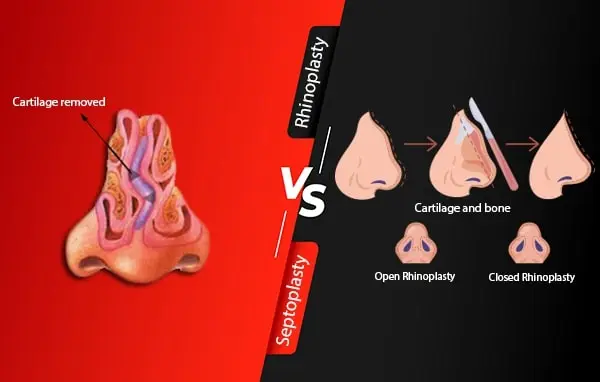When to Have Rhinoplasty with Septoplasty?
When to Have Rhinoplasty with Septoplasty
Rhinoplasty and septoplasty are two distinct surgical procedures involving the nose, often performed together to address both aesthetic and functional concerns. Understanding when to have these surgeries, the differences between them, their costs, and recovery processes are crucial for making informed decisions. This article delves into these aspects, focusing on the UK audience.
What is the difference between rhinoplasty and septoplasty?
Rhinoplasty and septoplasty are often confused due to their involvement with the nose, but they serve different purposes. Rhinoplasty, commonly known as a « nose job, » is primarily performed to alter the nose’s appearance. It can correct a variety of issues, including size, shape, and proportions of the nose, and it can also repair deformities caused by injury or birth defects. Septoplasty, in contrast, is a functional surgery aimed at correcting a deviated septum. The septum is the internal wall that divides the nostrils. When it is deviated, or crooked, it can cause breathing difficulties, chronic sinusitis, snoring, and even sleep apnea. Septoplasty straightens the septum, allowing for improved airflow and better breathing.
When considering septoplasty vs rhinoplasty, it’s essential to understand that rhinoplasty is typically elective and cosmetic, while septoplasty is usually medically necessary to improve nasal function. However, these procedures can be performed simultaneously, known as septo rhinoplasty, to achieve both aesthetic and functional improvements in one surgical session.
Can I get rhinoplasty with septoplasty?
Combining rhinoplasty and septoplasty is common, especially for individuals seeking to enhance their nasal appearance while also addressing breathing issues. This combined procedure, known as septo rhinoplasty, offers several advantages. Firstly, it allows patients to undergo one surgery and one recovery period rather than two separate ones, reducing overall downtime and potential discomfort. Septo rhinoplasty is particularly beneficial for those with a deviated septum and cosmetic concerns about their nose’s shape or size. By addressing both issues at once, the surgeon can ensure that the structural changes to improve breathing do not compromise the aesthetic outcomes, and vice versa. This holistic approach often leads to better overall results and higher patient satisfaction.
What is the average cost of septoplasty and rhinoplasty?
The cost of septoplasty and rhinoplasty can vary significantly based on the complexity of the procedures, the surgeon’s expertise, and the geographic location. In the UK, the cost of septoplasty typically ranges from £3,000 to £6,000. This price usually includes surgeon fees, anesthesia, and hospital charges. Rhinoplasty costs are generally higher due to the complexity of the procedure and the detailed work involved in reshaping the nose. Prices for rhinoplasty in the UK can range from £4,000 to £7,000. When both procedures are combined in a septo rhinoplasty, the total cost can range from £6,000 to £10,000, depending on the specifics of the surgery and any additional treatments required. It’s important for patients to have a detailed consultation with their surgeon to understand the costs involved and what is included in the quoted price. Some clinics may offer financing options or payment plans to help manage the cost of these surgeries.

What is the recovery from septoplasty and rhinoplasty like?
Recovery from septoplasty and rhinoplasty varies from patient to patient, depending on the extent of the surgery and individual healing rates. Generally, patients can expect some swelling, bruising, and discomfort in the first few days following surgery. Pain can usually be managed with prescribed medications, and it is essential to follow the surgeon’s post-operative care instructions closely. For the first week, patients are typically advised to rest and keep their heads elevated to reduce swelling. Most people can return to work within 1-2 weeks, but it is crucial to avoid strenuous activities for at least a month to ensure proper healing. Activities that could impact the nose, such as contact sports, should be avoided for several months. The full recovery process for septo rhinoplasty can take up to a year, as residual swelling gradually subsides and the nose settles into its final shape. Regular follow-up appointments with the surgeon are necessary to monitor healing and address any concerns that may arise.
What is functional rhinoplasty?
Functional rhinoplasty is a term used to describe rhinoplasty procedures that are performed primarily to improve nasal function rather than aesthetics. This type of surgery is often necessary for individuals with structural issues that impede breathing, such as a deviated septum, nasal valve collapse, or other abnormalities affecting airflow. While functional rhinoplasty may also result in aesthetic improvements, the primary goal is to enhance nasal function. For example, patients with a deviated septum might undergo a combination of septoplasty and rhinoplasty to not only straighten the septum but also address any external nasal deformities that could affect breathing. This comprehensive approach ensures that both internal and external nasal structures support optimal function.
What is turbinate reduction?
Turbinate reduction is a procedure often performed alongside septoplasty and rhinoplasty to further improve nasal airflow. The turbinates are structures within the nose that help humidify and filter the air we breathe. However, enlarged turbinates can block airflow and contribute to breathing difficulties. Turbinate reduction involves reducing the size of these structures, typically through methods like radiofrequency ablation, laser treatment, or surgical excision. When combined with septo rhinoplasty, turbinate reduction can significantly enhance nasal breathing and overall function. This procedure is particularly beneficial for individuals who suffer from chronic nasal congestion that has not responded to other treatments.
Do I need a rhinoplasty and septoplasty surgeon near me?
Finding a qualified rhinoplasty and septoplasty surgeon near you is crucial for several reasons. Proximity to your surgeon allows for easier access to pre- and post-operative care, which is essential for monitoring recovery and addressing any complications promptly. Local surgeons are also more familiar with regional healthcare standards and regulations, ensuring a higher level of care. Moreover, having a local surgeon means you can attend all necessary follow-up appointments without the added stress of long-distance travel. It is also easier to build a rapport with your surgeon, which can improve communication and overall satisfaction with the results. When selecting a surgeon for septo rhinoplasty, it is important to research their qualifications, experience, and patient reviews. Personal referrals, consultations, and viewing before-and-after photos of previous patients can help you make an informed decision. A skilled surgeon with extensive experience in both functional and cosmetic nasal surgeries will be better equipped to deliver the desired outcomes.
Understanding the intricacies of septoplasty vs rhinoplasty, the benefits of combining these procedures, the associated costs, recovery expectations, and the importance of local expertise can help patients make informed decisions about their nasal surgery options. Whether addressing cosmetic concerns, functional issues, or both, the right approach can significantly improve both appearance and quality of life. By consulting with a qualified surgeon and carefully considering your options, you can achieve the best possible results from your septo rhinoplasty.

